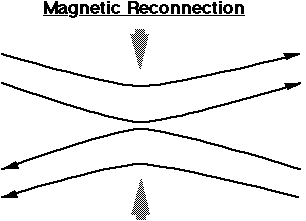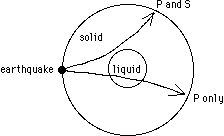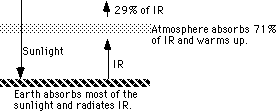 Plasma
is electrically conductive and can be trapped in magnetic field, because:
Plasma
is electrically conductive and can be trapped in magnetic field, because:
1. Magnetospheres
A) The Earth is a magnet (magnetic compass)
| a) "Magnetosphere": | It is a cavity in the solar wind and |
| Contains Earth's magnetism | |
| Contains plasma from Earth's atmosphere and solar wind |
| Plasma: | Gas with free electrons and ions. |
| 99% of universe is plasma (reason we study plasmas in the solar system). |
| Ion: | Atom with some electrons knocked off by UV or collision with electrons |
 Plasma
is electrically conductive and can be trapped in magnetic field, because:
Plasma
is electrically conductive and can be trapped in magnetic field, because:
charged particles only move freely along magnetic field lines, but are forced into circles around the field lines.
Key regions in the magnetosphere:
b) Van Allen radiation belts (1958):
charged particles spiralling on earth's magnetic lines.
c) The solar wind produces a "geomagnetic tail" -- points away from sun.
Corona changes Þ solar wind changes --> magnetosphere changes
Leads to magnetic reconnection in tail and on front
reconnected field lines behave like extended rubber band
-> can accelerate charged particles (electrons and ions)
d) The Aurora
| Reconnection | --> high energy electrons | |
| --> spiral down magnetic lines | ||
| --> hit upper atmosphere in polar regions | ||
| Þ light | ||
| Auroral analogy: | a big TV screen in the sky |
Auroral ovals: N & S hemispheres, around the magnetic poles
Aurora not likely directly at the N and S geographic poles
 B)
Other planets have magnetospheres.
B)
Other planets have magnetospheres.
Jupiter's magnetosphere is the largest "object" in solar system
Saturn, Uranus, Neptune have magnetospheres
If you want to see reconnection of magnetic field lines in motion,
go to the Reconnection Movie.
2. Planetary Magnetic Fields
Possibilities:
| Convection of liquid iron in Earth's core | and | |
| Rotation of Earth | -> magnetic field |
a) Density of Earth
b) Seismology
| Earthquake | --> compressional (P) waves (like sound) | |
| Þ shear (S) waves (like wave on string) |
We deduce that the earth has a liquid core:

Resulting picture of the Earth's interior with 3 layers:
| Crust | < 100 km | rocks | solid | |
| Mantle | < 2900 km | rocks | solid | |
| Core | rest | very heavy; Fe, Ni | liquid |
c) Hot interior from radioactivity
d) Convection:
| Results: | -> magnetism |
| -> formation of surface structures (volcanoes, plate motion) |
| Electrically conducting substance | and | |
| Motion (rotation and/or convection) in interior |
a) Inner Planets
| Earth: | Molten iron core and Rotation | ||||
| Heat Þ convection | -> magnetism. | ||||
| Venus: | Molten iron core (evidence: dense; active volcanoes) | ||||
| but very slow rotation | -> no magnetism. | ||||
| Mercury: | Iron core (evidence: dense) | ||||
| May not be molten (evidence: no heat flow from interior) | |||||
| Very slow rotation | |||||
| but here is weak magnetism | -- a riddle | ||||
| Mars: | No liquid iron core | ||||
| (evidence: low density, iron in surface, no active volcanoes) | |||||
| Very weak magnetism in spite of fast rotation as Earth. | |||||
Planetary Magnetic Fields: Inner Planets
| Earth | Venus | Mercury | Mars | Moon | |
|---|---|---|---|---|---|
| Magnetic Field | Yes | No | Weak (riddle) | No | No |
| Liquid Iron Core | Yes | Yes | Iron but solid | No | No |
| Rotation Period | 24 hours | 240 days | 58 days | 24.5 days | 28 days |
b) Outer Planets
| Composition of giant planets: | like Sun (75% H, 23% He, rest heavy elements) | |
| But interior: | compressed that H is metallic (in Jupiter and Saturn) |
Planetary Magnetic Fields: Outer Planets
| Jupiter | Saturn | Uranus | Neptune | |
|---|---|---|---|---|
| Magnetic Field | Yes | Yes |
Yes, off center and strange direction |
Yes, off center and strange direction |
| Hot Liquid Interior | Yes: metallic hydrogen | Yes: metallic hydrogen | Yes: Water | Yes: Water |
| Rotation Period | ~10 hours | ~10 hours | ~17 hours | ~16 hours |

3. Surface of Planets and Moons
| Coast lines of continents (Africa and America) fit together | |||
| Motion of continents (2 - 4 cm/year) | |||
| Convection | --> continental drift | --> Earth's early history has been erased | |
| Continental drift carries earth's surface over the hot spots | ||
| --> chains of small volcanoes. | ||
look around:
| Mars: | dead volcanoes | ||
| Venus: | active volcanoes | ||
| (evidence: we detect volcanic gases in Venus' atmosphere) | |||
| Mars and Venus have no continental drift. | |||
| Volcanoes sit over hot spots --> huge volcanoes | |||
a) Tidal volcanism
| Tidal flexing (from passage of next moon) + internal friction --> heating. | |||
| (Different from volcanoes on Earth: from radioactive heating!) | |||
| Hot enough to melt sulfur | |||
| Water geysers (?) on Saturn's moon Enceladus and Jupiter's Europa | ||
| --> snow and bright surface. | ||
| Tidal flexing enough to heat water. | ||
b) Sun driven volcanism:
| Ice geysers on Neptune's moon Triton. | |||
| sun-driven liquid nitrogen volcanoes (?) | |||
| Comets in the inner solar system: ejection of material | |||
| sun-driven ejection | |||
D) Craters on Moon and Mercury
| many craters on the surface | |||
| -> no change by weather as on Earth | |||
| -> no atmosphere | |||
| possible reason for craters on the moon and Mercury? | |||||
| Volcanoes? | no evidence, not the right conditions | ||||
| Impacts? | yes, lots of debris in the solar system | ||||
a) Crater size depends on energy of object, not on its size
b) Most craters found throughout the solar system are the remains of the last objects to fall onto the planets or moons during formation
Earth has few visible craters because of
| - plate tectonics (renewal of surface) | |
| - weathering |
a) Age determined from rocks sampled by Apollo astronauts
| oldest rocks ~ 4.5 billion years |
b) Method:
| radioactive decay | e.g., Thorium | -> several steps | -> lead | ||
| ratio of lead/thorium is measured | -> age | ||||
| a) | Earth and Moon Formed Together | Twin Model | |
| Problem: | Density of the Moon < Density of the Earth | ||
-> Not Formed from Same Material
| b) | Moon Captured by the Earth | Spouse Model | ||
| Problem: | Object approaching planet from far away | |||
| does not orbit without deceleration | ||||
| -> Cannot Be Captured | ||||
| c) | Moon Ejected from Earth After Impact | Child Model: | |
| Evidence: | Density = Earth's Mantle | ||
| Composition = Earth's Mantle | |||
| Moon contains few volatile materials (water, gases) | |||
| Þ heating during impact? | |||
| Big impact | Þ other early moons Þ | ||
| collide with each other Þ debris Þ | |||
| collide with the Moon Þ Moon's craters(?) | |||
-> Current Best Model
Speculation: The impact which formed the moon may have removed earth's early CO2 atmosphere. This may be why we are not like Venus.
4. Planetary Atmospheres
| high temperature | -> gas molecules faster | -> escape easier | |||
| larger planet | -> stronger gravity | -> keep gases around planet | |||
| Mercury: hot and small | -> no atmosphere | ||||
| Moon: | small | -> no atmosphere | |||
a) selective absorption of light

b) Greenhouse gases:
| Water vapor (deserts get cold at night). | ||
| Early earth: water vapor --> strong greenhouse. | ||
| Carbon dioxide (CO2). | ||
| Methane (not much methane but a very strong absorber). | ||
| c.f. | Venus: | CO2 atmosphere --> strong greenhouse --> hellish place (>480 C) |
| Mars: | Thin CO2 atmosphere. (cold) | |
| Venus, Mars have CO2 --> Earth probably started with lots of CO2 | ||
Where did Earth's CO2 go?
| i. Water dissolves CO2 (e.g. soda pop). | |||
| Water + CO2 Þ carbonic acid. | |||
| Carbonic acid + Calcium or Magnesium salts (washed into ocean by rivers) | |||
| Þ precipitated carbonates | Þ settle to bottom of ocean | ||
| Þ limestone (calcium carbonate), magnesite (magnesium carbonate) | |||
| sedimentary rocks. | |||
| ii. Life stored CO2. | |||
| e.g. chalk or oil and coal deposits | |||
| iii. Volcanoes release the CO2 stored in rocks | Þ cycle | ||
| Importance of volcanoes: Add CO2 and water to atmosphere | Þ greenhouse | ||
| Thus recycle CO2 from buried carbonate rocks | |||
| May have happened in the past on Mars, but not recently |
| Mercury too hot and no atmosphere | ||
| Venus too hot | -> water vapor | |
| -> destroyed by intense solar UV | ||
| Water on Earth important for life | -> What about Mars? |
A) White polar caps which show seasons
| -> dry ice (CO2), cannot be pure water (atmospheric pressure too low) |
B) Mars canals were reported (Schiaparelli, last century)
| only seen with human eye, not on photographs | ||
| (the eye/brain connects uncorrelated dots) |
But more recently riverbeds found -->
| Mars had liquid water (evidence: riverbeds) |
--> thick atmosphere in past | |
| Where did Mars' water go?? | ||
| Low pressure atmosphere | --> water cannot exist as liquid | |
| (c.f. 'dry' ice is left in polar caps) | --> water vapor broken up by solar UV | |
| or buried by permafrost |
| reasonable temperature: presumably 0 C < temperature < 100 C | |
| atmosphere with reacting gases: O, N, CO2, and/or methane | |
| a liquid, in which life can thrive (on Earth: liquid water; anything else??) |
We may find surprises!!!
| Saturn known for beautiful ring system | but also found | |
| at Uranus, Neptune and Jupiter | ||
a) Why a ring and no moon?
| -> Tidal forces: Roche Limit | is due to Competition between: |
| Tides from planet | --> try to tear apart a moon | ||
| Self-gravity | --> tries to hold moon together | ||
| Inside the Roche Limit: | tides win. |
| Tides will overwhelm self-gravity and tear apart a moon inside the Roche Limit. | ||
| This will happen to Neptune's Triton when it comes closer to the planet! | ||
| Or tides will prevent a moon from forming inside this distance | ||
| Almost all rings are inside the Roche limit. (Saturn, Jupiter, Uranus) | ||
b) Why are the rings so stable and sharply structured?
| It's all gravitational interaction! | |
| Shepherd satellites "focus" skinny rings, which would be expected to "diffuse" |

Sharp edge of Saturn's A ring: small moon just beyond the ring
Encke division in Saturn's A ring: small moon slinging particles out of the division
8. Small bodies in the solar system
a) have very eccentric orbits -> come from freezer into warm sun -> evaporation
b) have 2 tails
| dust tail | -> comet dust | |
| -> driven by radiation pressure of the sun | ||
| plasma tail | -> gas from comet gets ionized by UV light of the sun | |
| -> blown by solar wind | ||
| (first recognition of solar wind (Biermann, 1949) |
investigated by active experiments (artificial comets)
c) comet is dirty snowball (fluffy configuration) (Whipple)
| but under bombardement from solar wind and cosmic rays | |
| -> tar-like substance on surface | |
| -> very dark surface (observed by Giotto) | |
| -> material comes out in bright geysers |
d) come from Oort Cloud of comets -- way beyond Pluto.
Comet orbits suggest a huge reservoir of objects far away. However, they could not have formed there, wasn't enough material out there.
They probably formed near U and N and got ejected by a slingshot by J, S, U, N
provided the only hands-on material for a long time
| Debris of the solar system | --> hit Earth's atmosphere ("meteors") | |
| --> called "meteorites" if they land |
There are three types of meteors: Carbonaceous, stony, iron
a) break-up comets
| - meteor showers along comet orbit | ||
| - fluffy structure like comets, break-up of comets observed | ||
| Carbonaceous chondrites contain volatiles | ||
| --> no differentiation | ||
| --> sample of early solar system like comets. | ||
b) from asteroid belt
| Asteroids collide | --> small debris ("meteoroids") | |
| Iron and Stony meteorites |
--> some asteroids were big enough for differentiation.
c) Impacts and life:
i )Carbonaceous chondrites contain water & complex molecules including amino acids
| --> building blocks of life were there at the beginning of the solar system. | |
| Comets and water-bearing asteroids may have been |
early sources of water and building blocks of life.
ii) Major extinction of life 65 million years ago.
| Dust or CO2 , from an impact: | change of climate ? | |
| killed dinosaurs and other life forms? | ||
| Evidence: | Iridium is very rare on Earth | |
| (likes to be with iron so most of it probably sunk to the Earth's iron core). | ||
| Iridium is much more abundant in iron meteorites. |
1980: Luis (Nobel prize for something else) and Walter Alvarez found a 65 million year old layer of rock with a lot of iridium.
| Conclusion: | Þ the iridium came from space. |
| Amount of iridium | --> the object must have been 10 km across |
| Þ it would have made a crater 150-200 km in diameter. |
A crater of the right age and size (~ 300 km) has been found in Yucatan.
| Alternate theories: | - lots of volcanoes changed climate |
| - radiation from nearby supernova killed life |
But: not too much credibility any more, after crater was found.
| Riddle: | Life began 3.8 billion years ago. | ||
| But there was intense bombardment up to 3 billion years ago | |||
| --> dark dusty sky and boiling of oceans. | |||
| How did life start under these conditions? |
9. General Features of Planets
| Almost in the same plane | |
| Almost everything has same sense of spin |
| Close to sun: | rocky planets and rocky debris |
| Far from sun: | gaseous planets, icy satellites, icy debris (comets) |
| Exception: | Pluto and Charon are ice + rock -- a riddle |
| Did they get knocked out of Neptune's system of moons? | |
| Are there lots of Plutos out there? |
| Close to sun: | "volatile" stuff evaporated | --> "refractory" stuff remains |
| Far from sun: | cold --> even gases could accumulate without escaping gravity | |
| Result: | giant gaseous planets J,S,U,N far from sun |
C) Similarities in Jupiter's system:
| Close to Jupiter: | Io and Europa are rocky |
| Far from Jupiter: | Ganymede and Callisto are ice + rock |
| Conclusion: | Jupiter produced heat (from gravitational energy) while it formed |
To be explained by model on solar system formation!
10. Planets in Other Star Systems
| Motion of the star in response to the planet's gravitational pull | ||
| - transverse motion in te sky | ||
| - motion away or towards us (Doppler effect) | ||
|
Plan to build huge telescope clusters in space to see these planets Find out more from JPL's Planet Quest website. |
||
| Planets of pulsars (probably not from star formation) | |
| Jupiter-size planets close to the star | |
| Jupiter-size planets further away (similar to our solar system) | |
| greater than Jupiter-size planets in excentric orbits (more like binary stars) |
This is just the beginning, the heavy ones are the easiest to find.
C) Consequences of the Findings
| -> planetary systems probably a general feature of stars | |
| -> possibly many, many planetary systems in the universe | |
| -> opens many chances for life to emerge! | |
| -> planetary systems may be more diverse than our solar system |
Go to Chapter VII